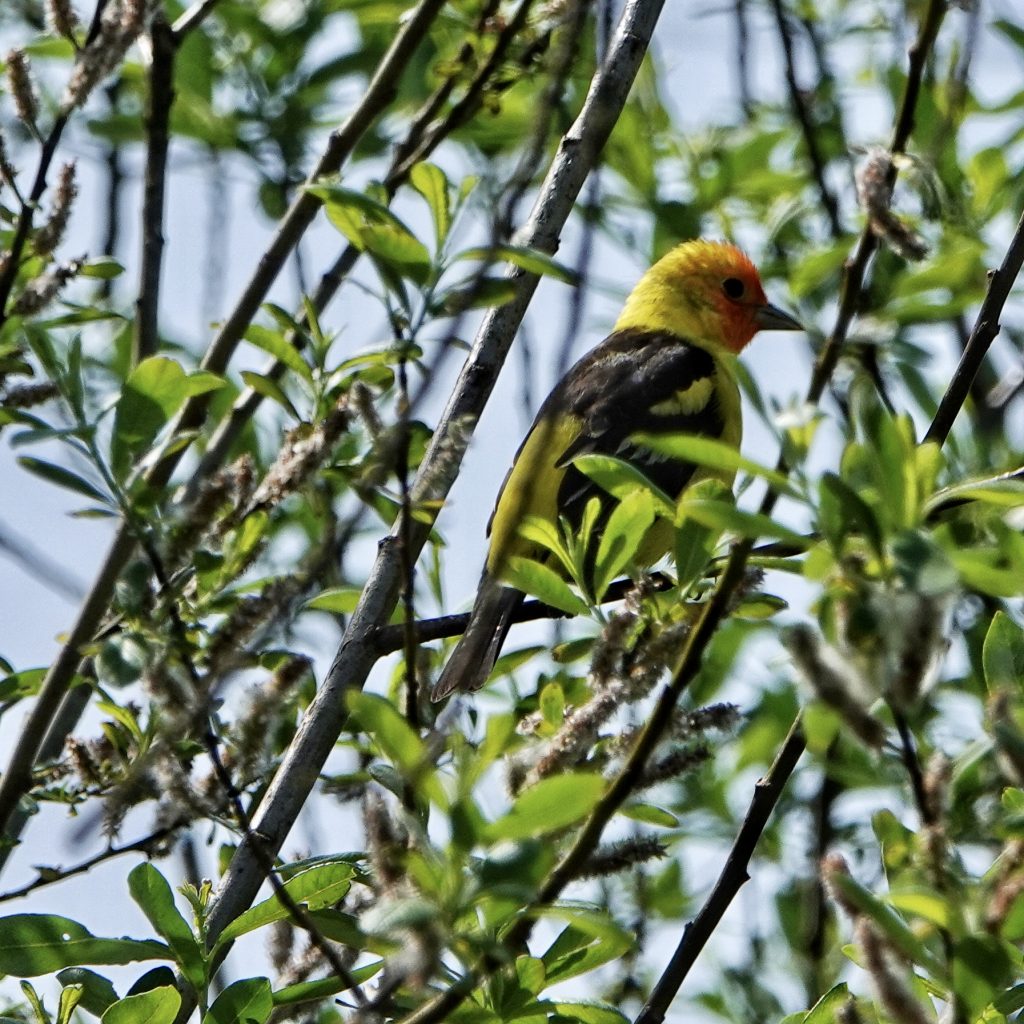
Western Tanagers are always an exciting bird to see, flashing that bright red head and yellow body, with the black wings creating a strobe effect. I was really surprised, in the aftermath of seeing my first one, to find out that they are only 7” tall, the same size as a Golden-crowned Sparrow. They seem so much larger in the landscape, a bold, outsize presence that fills the eye. The first one I saw this year was at least 40 or 50 yards away, flying through a clearcut as I drove the road that parallels it. Yet I knew, beyond a doubt, that it was a Western Tanager, and even somehow had a detailed image in my mind, something that just isn’t actually possible for my unaided eyes at that distance, with a bird that small.
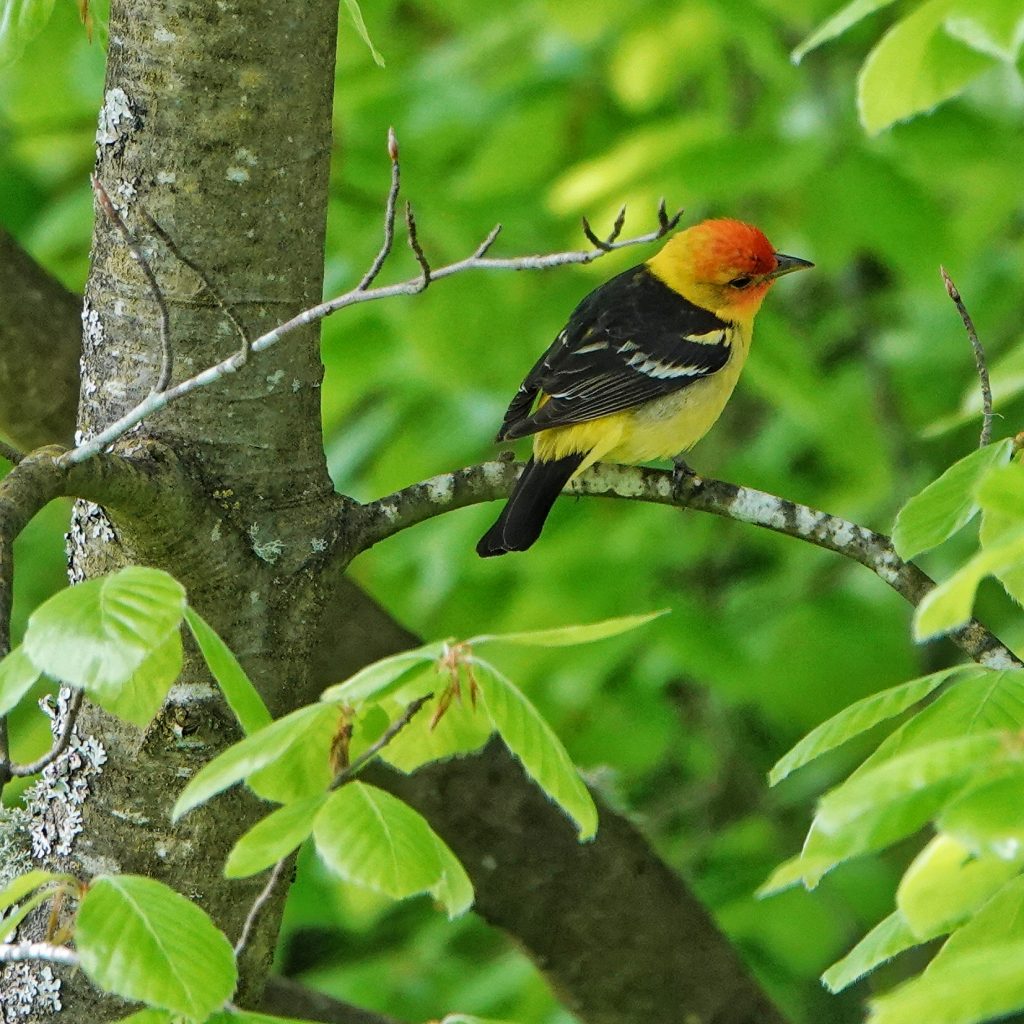
They are here and gone so quickly that familiarity never has time to even breed, well, familiarity. Here in the lowlands of Clark County, Washington they will be seen with regularity from Mother’s Day to Father’s Day if we’re lucky, and then they’re gone. I know they are breeding up in the mountains, and that they pass through again on their way south, but for whatever reason I only seem to see them during that 5 week period when spring is breaking into summer. One glorious Memorial Day weekend we stopped at Catherine Creek on the way to the Wenas Campout, and saw dozens during a couple hour hike, like flames shooting from tree to tree, or dancing in space against an azure sky. It was breathtaking! On the way back 3 days later we stopped again, and didn’t see a one.
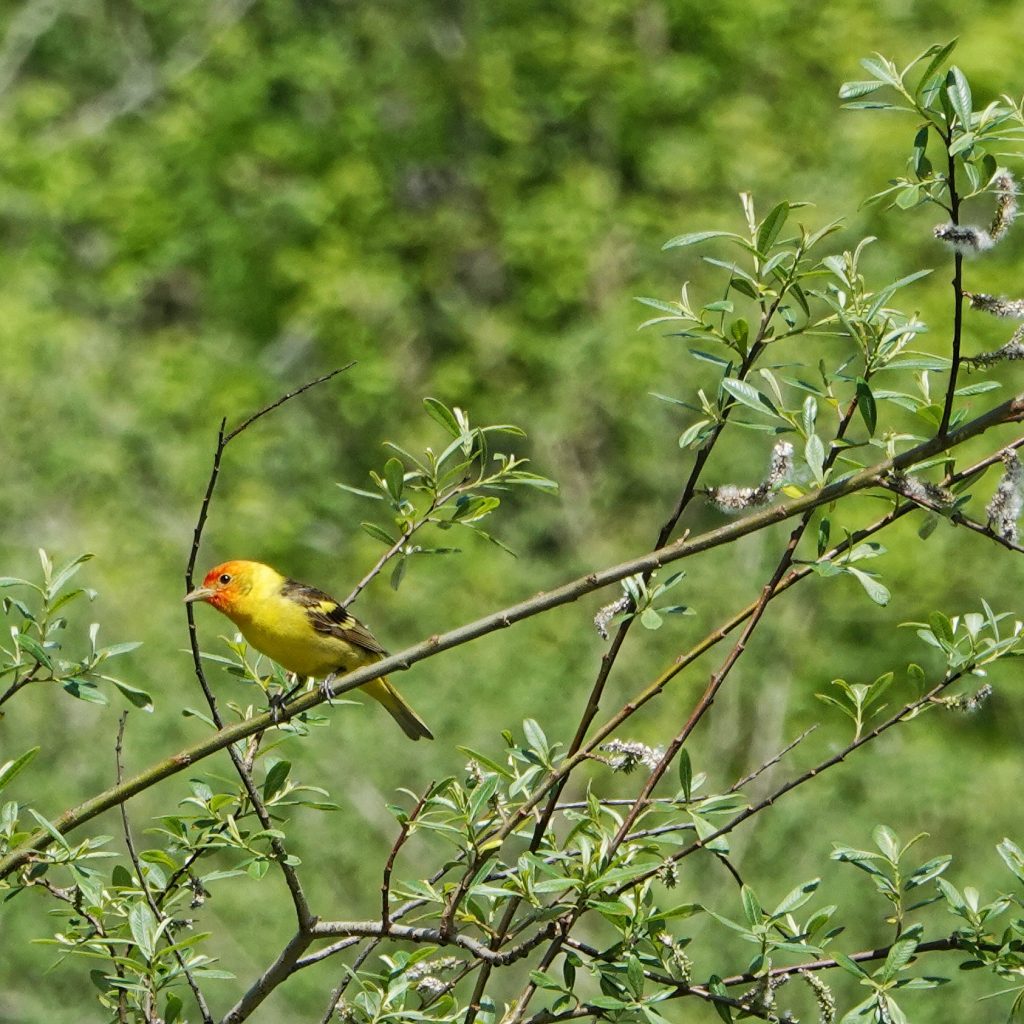
It is interesting to note that the bright red orange pigmentation on the head of Western Tanagers does not derive from the usual avian source of 4-keto-carotenoids, although they do retain the ability to synthesize those pigments. However (as discussed in Hudon;1990) the pigment utilized by Western Tanagers is rhodoxanthin, which cannot be synthesized by any known bird species. It must be acquired from the environment, and is present in many conifers and ferns. But, since Western Tanagers do not consume these plants directly (except possibly for juniper and yew berries), they must get rhodoxanthin from insects that do consume them. It is unclear why this pigmentation option was selected for in the evolution of Western Tanagers, since they come from the same lineage as Scarlet Tanagers (and the two may even constitute a superspecies), and the red of the Scarlets is derived from 4-keto-carotenoids. It seems probable though that ingestion of large amounts of rhodoxanthin precluded the need for production of 4-keto-carotenoids, and thus either removed an energy drain, or eliminated a possible side effect of that production, such as producing oxidases which can generate oxygen radicals.
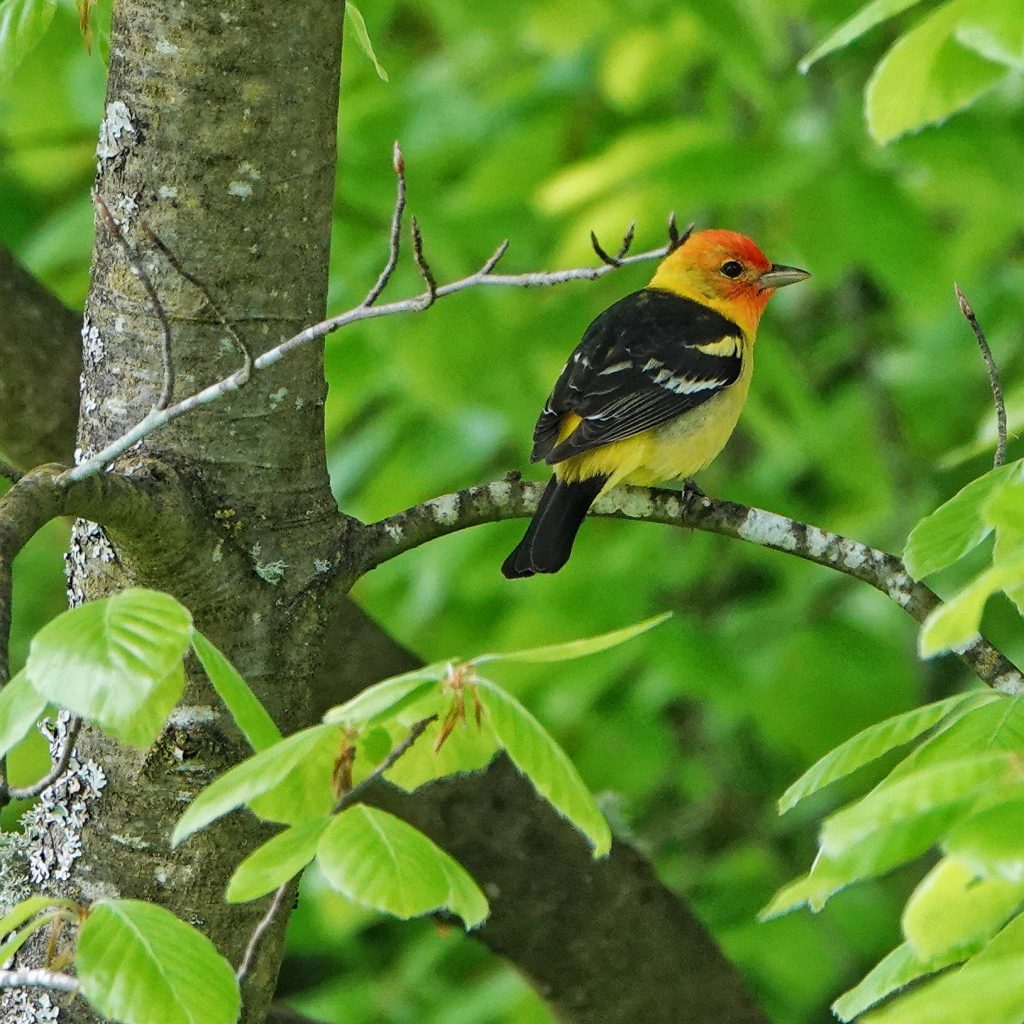
This is a bird that gleans methodically for arthropods and hawks flying insects from exposed perches. They are often found high up in trees and, seemingly oddly for such a brilliantly colored and spectacular bird, can be very difficult to pick out of the leaves, possibly because their black wings, tail, and back look like shadows and break up their outline, and the yellow bodies look like sun washed leaves. Good ear birders often locate them by their song, but I am not one of them and I find most of my Western Tanagers by tracking their hawking sorties.
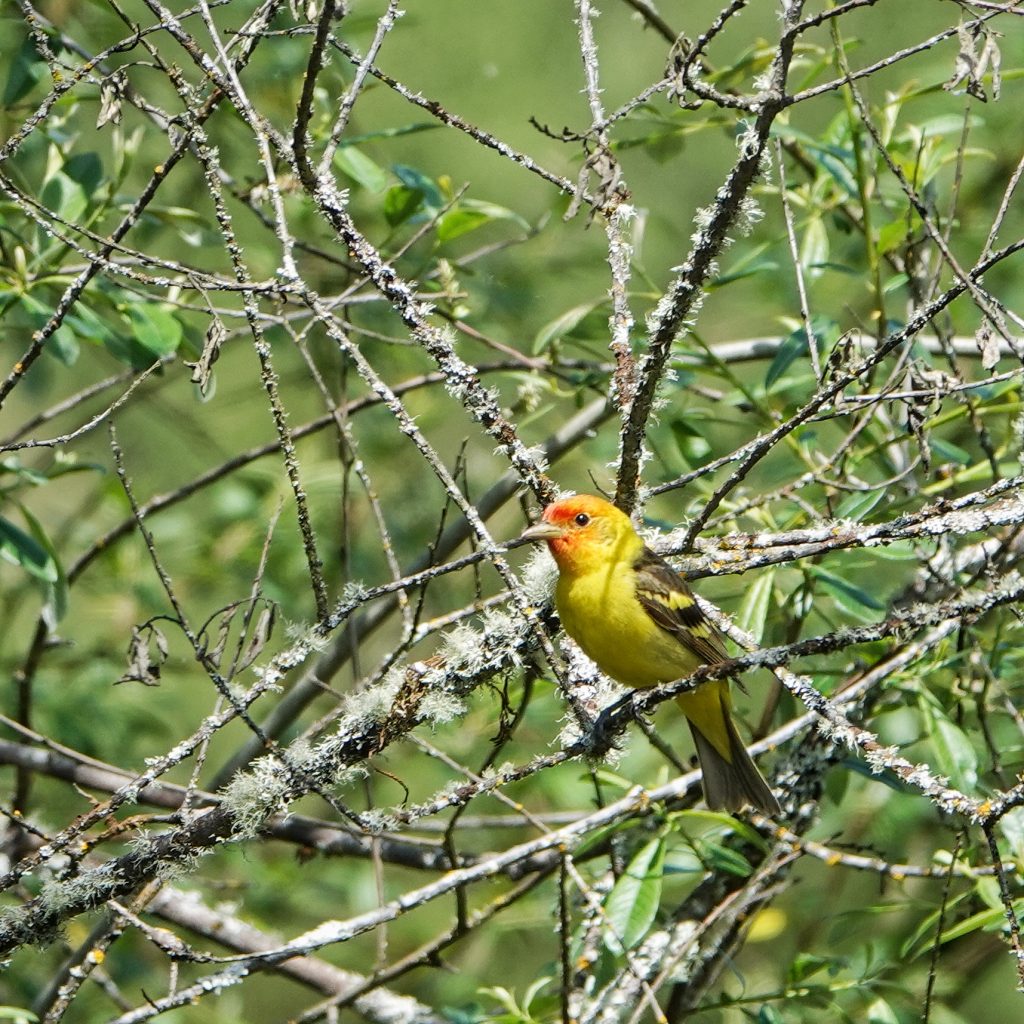
This species was first described by Alexander Wilson from specimens found by the Lewis and Clark Expedition in Kamiah, Idaho. At that time the whole region was still called ‘Louisiana’, and Wilson thus gave it the specific epithet ludoviciana (Latin for ‘Louis’) in honor of that territory. Molecular research in 2007 led to the genus Piranga being removed from the tanager family (Thraupidae) and placed into the cardinal family (Cardinalidae).
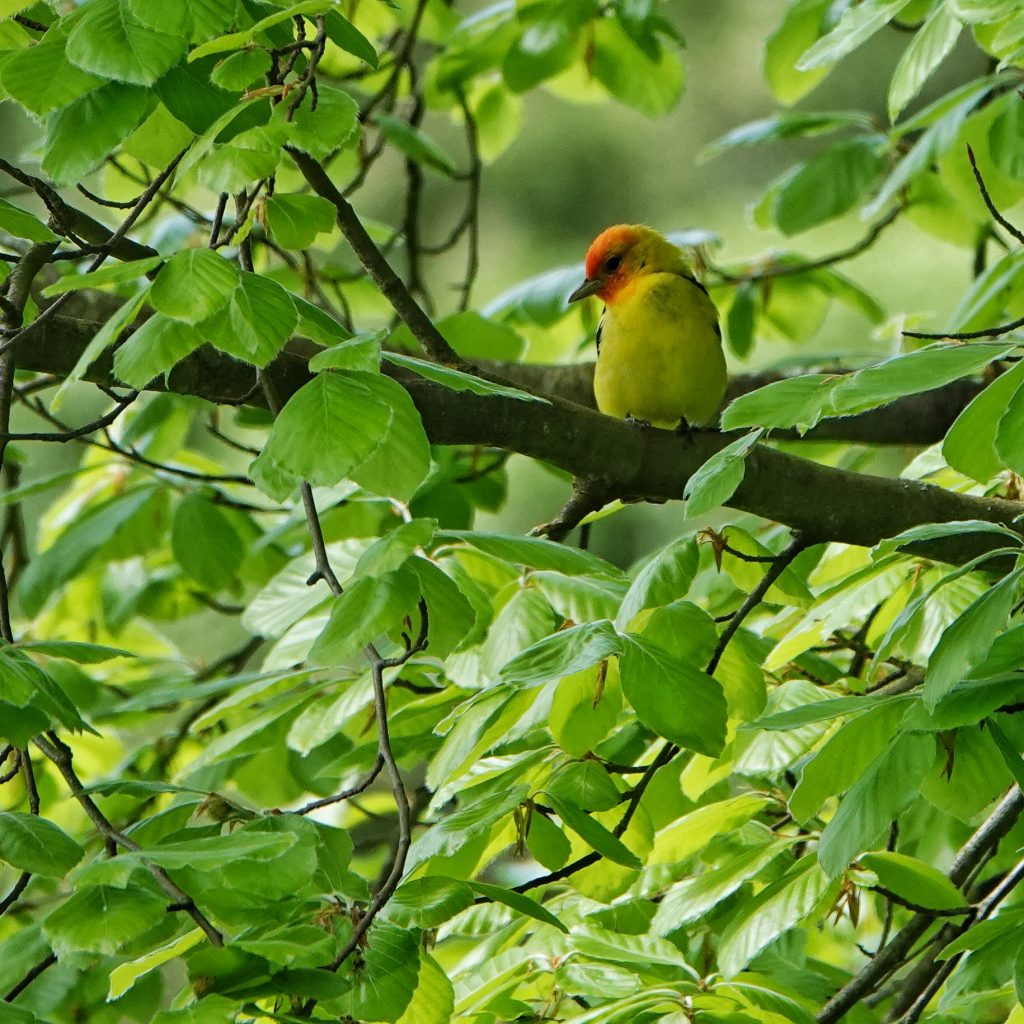
Description-Small (7” long) bird with a yellow body, black back, black wings that have a yellow upper wingbar and a white lower wingbar, a black tail, a stout orange bill, dark eyes, and blue grey legs; males in breeding plumage have a brilliant reddish orange head; females and secondary plumage males have a duller back, brownish yellow head, less vibrant wingbars, and less orange on the head.
Similar species-Summer Tanager and Scarlet Tanager lack wing bars, and are very rare vagrants from the east; Bullock’s Oriole males have a black crown, eyeline, and throat, and the females have grey wings, a whitish belly, and bright yellow head and breast; much larger than goldfinches.
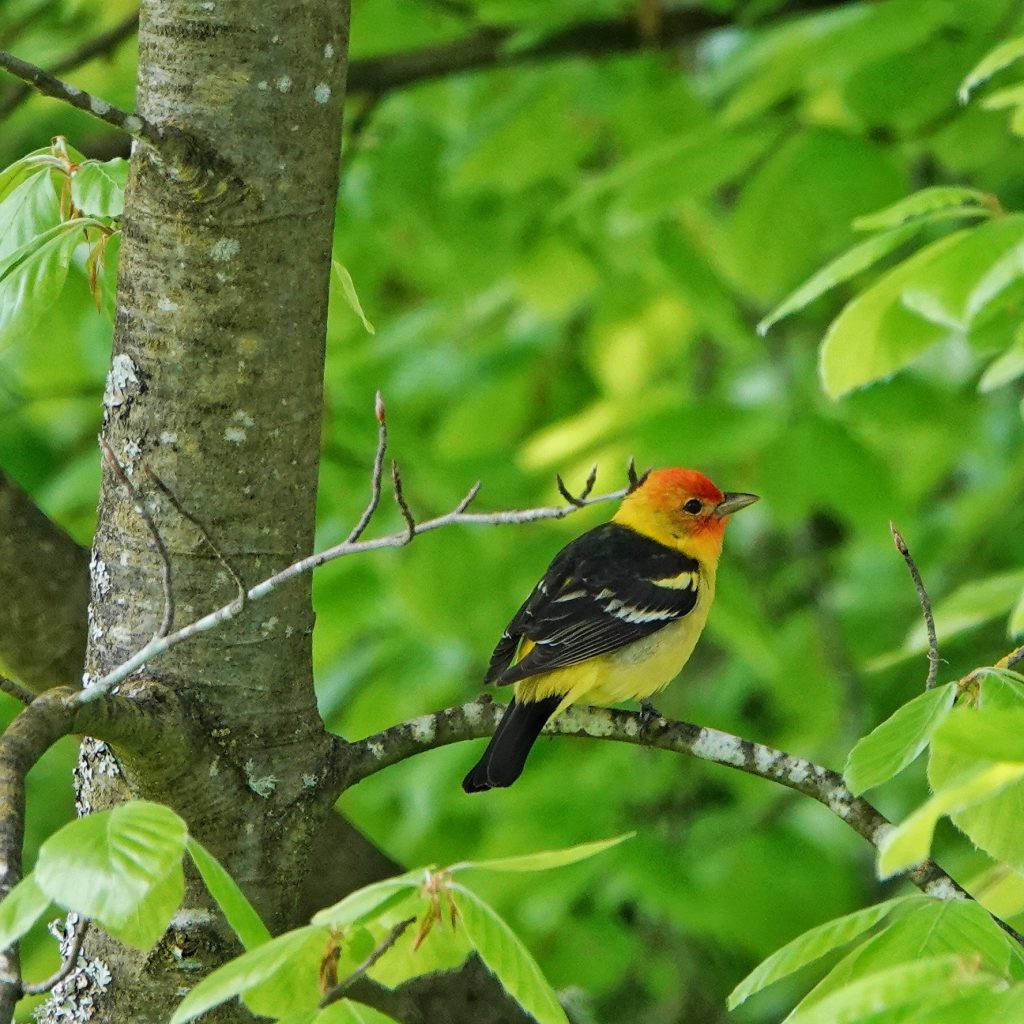
Habitat-Can be found anywhere during migration; Nests in conifer and mixed forests, usually at higher elevations, but occasionally at lower elevation in oak woodlands; usually found in pine/oak woodland in its winter range, and some are known to overwinter in eucalyptus groves in California.
Range-Western North America and Central America; winters in southern Mexico and Central America (and occasionally in California), breeds in mountainous regions from Arizona to the Northwestern Territory of Canada; can be found anywhere in our region during migration, but only in forested areas during breeding.
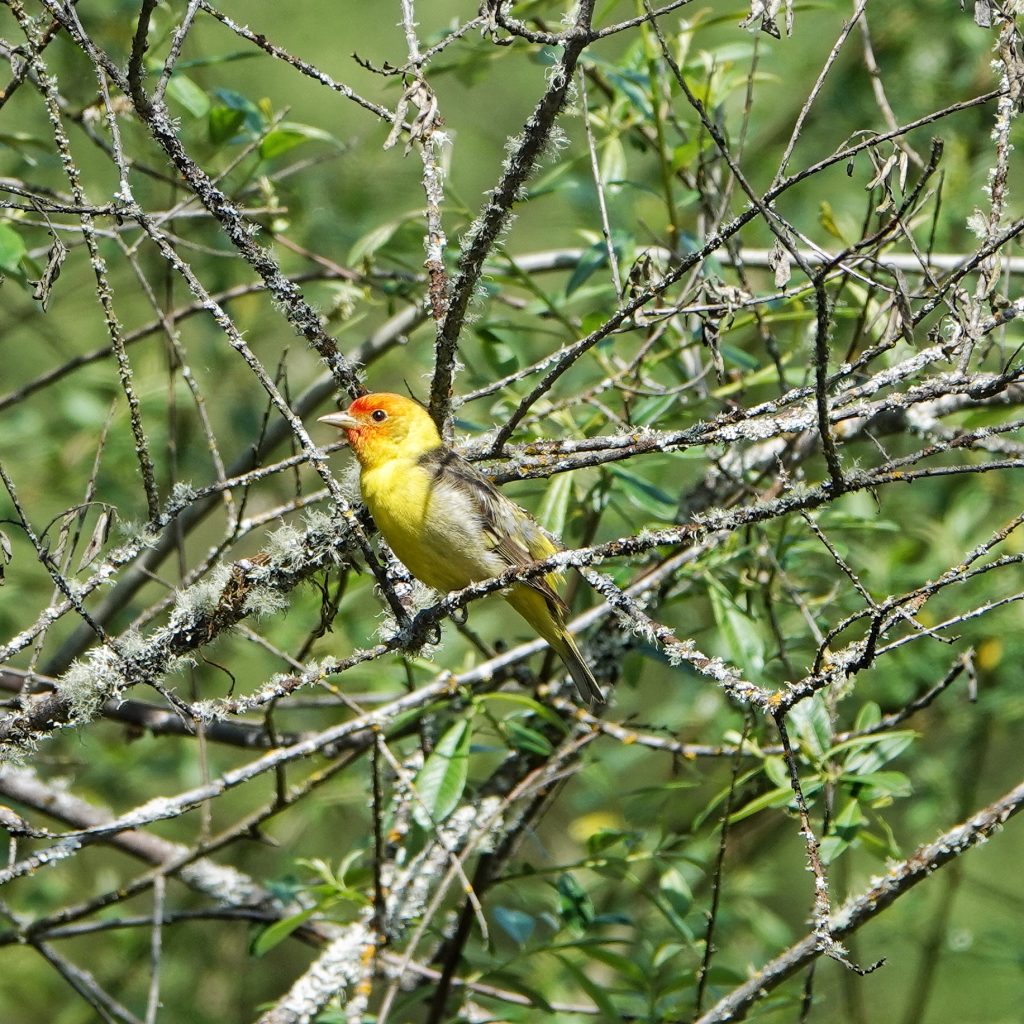
Eats– Primarily arthropods and flying insects; also eats small fruits and berries, and will come to orange sections and other fruits at feeders.
Eaten by– Young are probably vulnerable to predation by any carnivores that can reach them; adults are mostly preyed upon by bird hunting birds such as Cooper’s and Sharp-shinned Hawks and Northern Pygmy Owls.
Adults active-Adults migrate north through our area from late April through June, and adults and juveniles migrate south from late July through September; breeding pairs may be found from late May through July; not known to overwinter in our region.
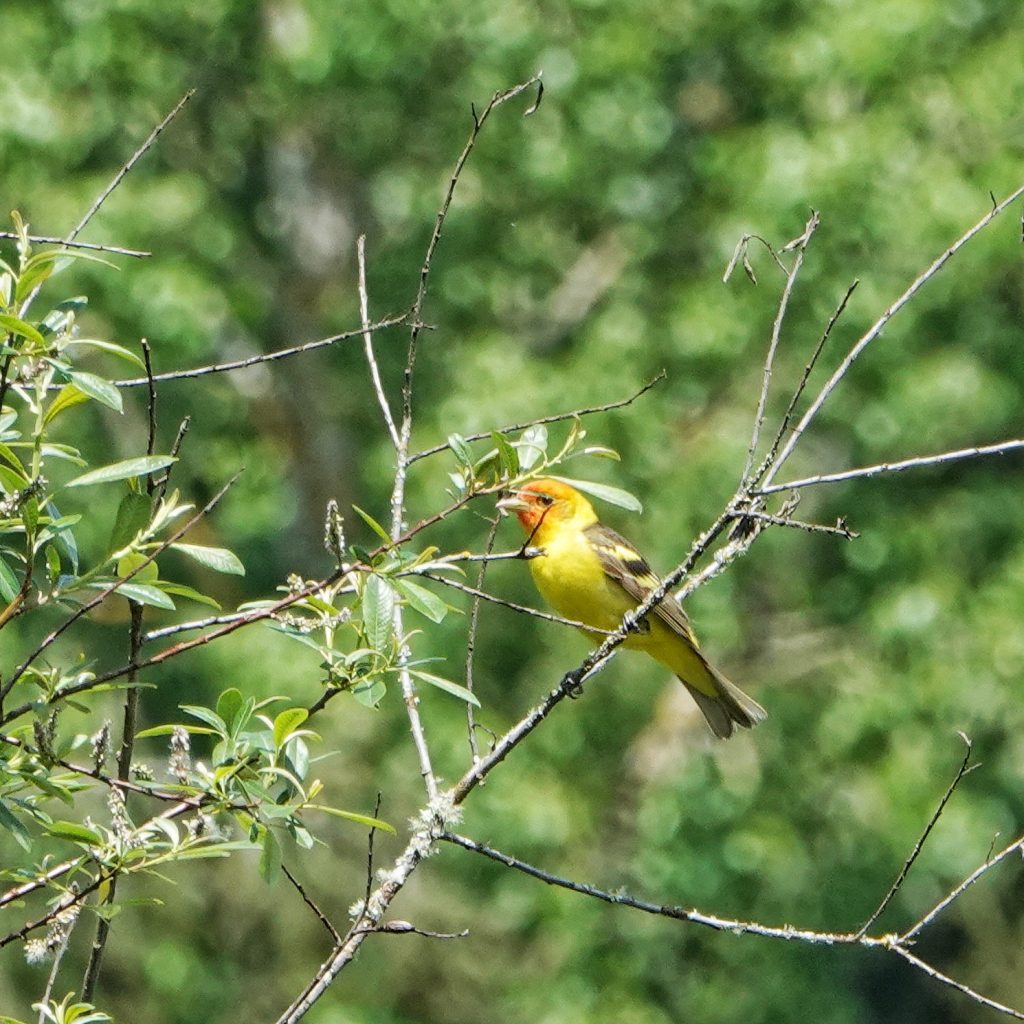
Life cycle-Usually builds nests in the limb forks of horizontal branches (primarily conifers) at least 10’ above the ground; nests constructed of twigs, moss, dried grass, hair, and rootlets; lays 3-5 pale blue eggs with dark markings; incubates eggs for 13 days, young fledge in 13-15 days; may raise 2 broods in optimal conditions, but usually only rears 1.
Etymology of names– Piranga is from the Tupi language (used by indigenous peoples of Brazil), and refers to an unknown, small bird. The specific epithet ludoviciana is from the Latin word for ‘Louis’, and refers to the Louisiana Colony of New France that was purchased by the US during the presidency of Thomas Jefferson.
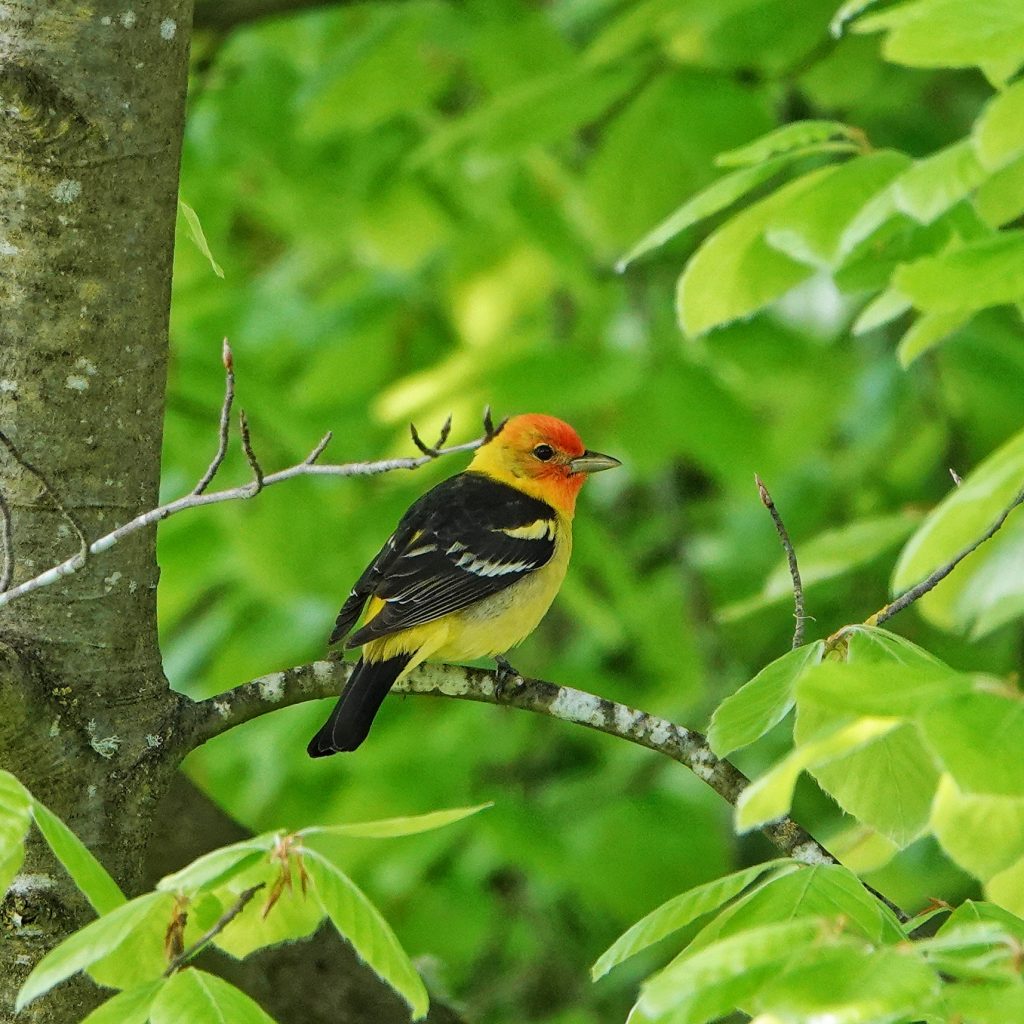
https://www.audubon.org/field-guide/bird/western-tanager
https://www.allaboutbirds.org/guide/Western_Tanager/overview
https://fieldguide.mt.gov/speciesDetail.aspx?elcode=ABPBX45050
https://animaldiversity.org/accounts/Piranga_ludoviciana/
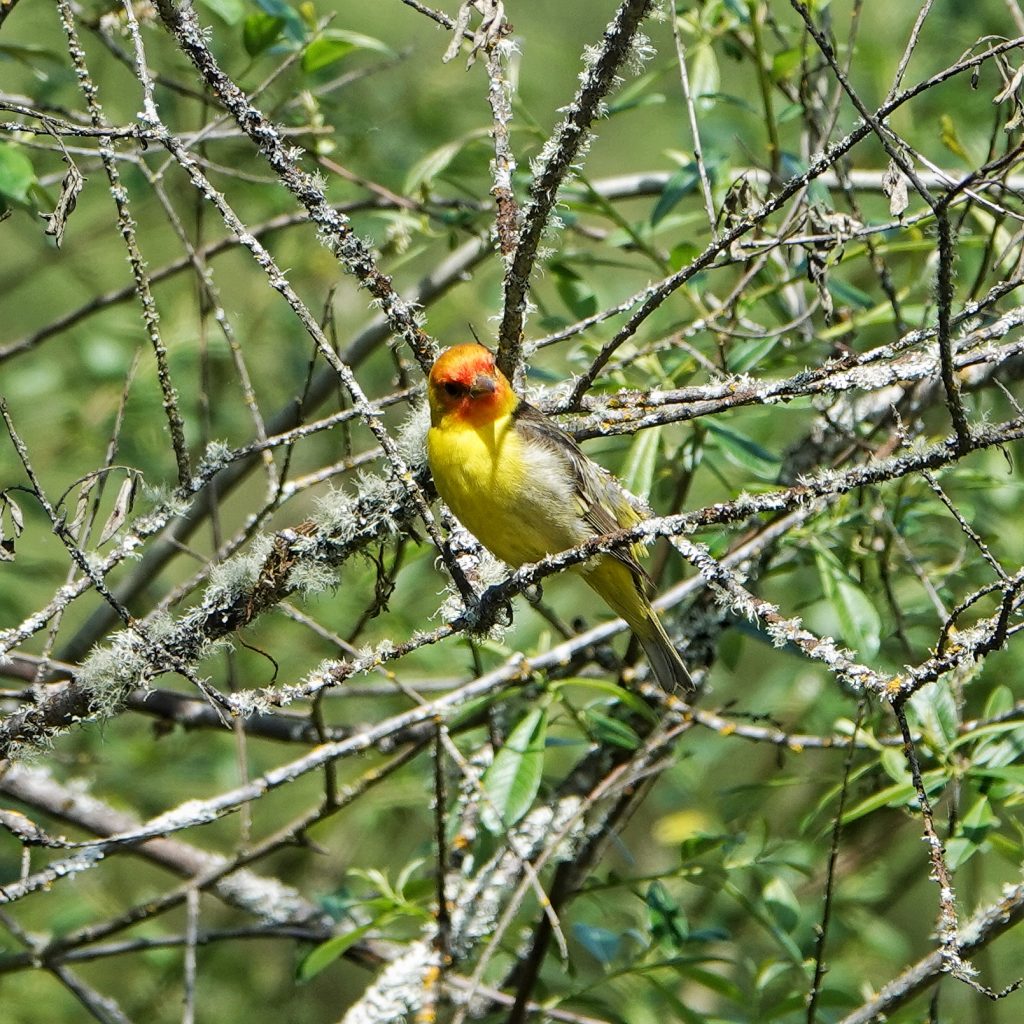
They’re in our yard on the other side of the state today, too!
Very cool!
While I’be seen these in the past, this was the first year I’ve been able to get a good photograph or two. Thanks for the great info!
Thanks for your appreciation, Bonnie!
I saw 3 in my backyard in Colorado.never before. The like the suet. fin to watch.
Glad to hear you got to see them, Rebecca!
I saw one for the first time also in Colorado – perched briefly in my aspen tree right outside my bedroom window. I got a good shot of it. He was a very bright spot on a gloomy day.
Glad to hear it, Diane!
Have been seeing tanagers for about 2 weeks here in Lafayette Oregon. We have woodpecker feeders hanging in fir trees outside of our kitchen window. We think there may be about 10 or so.
Very cool, Janice! Enjoy them while you can! Unfortunately, I have yet to see one this year.
We have tanagers this year! So exciting to watch as they enjoy the suet feeders. We filled our oriole feeder with nectar but haven’t seen them feed from it. Joyful to watch.
That’s very cool, Tonda and Joe! Thanks for sharing that!
We have quite a few of them at the China Bar Ranch, Vernita, Wash. A few hundred acres of Apple and Cherry trees next to the Columbia River provides habitat for a diverse assortment of bird species. Cedar Waxwings, American Goldfinches, (our state bird). There’s a pair of Swainson’s Hawks and a pair of Prairie Falcons nesting in the cliffs, and a pair of Northern Flickers in the back wall of the office. They don’t mind Archie the rubber Coral Snake hanging above.
Sounds like a wonderful place! Thanks for sharing that with us, Neal!
Had one beautiful male around my feeder for an entire day, then gone. Duluth, Minnesota is out of their range. We thought maybe with the fires in Alberta, he had been pushed east. Truly a peak experience!
Seems to be a banner year for them, Laurel! Glad you got to see one!
I had never seen one till this week when I was at Rose Hills in Whittier , California. It was so pretty . I was thrilled to see it and find out what it was. Took pictures of it but not as nice as these here in your article.
Thanks for your kind words, Vera!
We have two pair that came in to our kitchen window feeder along with two pair of Orioles,and a pair of Black headed Grosbeaks in May & June 2023. Our first time to enjoy these species. Although we have about 28 species visit annually our favorites are Evening Grosbeaks. When they come they bring a colony !
Thanks for sharing this!
245 Beautiful acres @Baileys on Palomar on Palomar Mountian ,California and I was lucky enough to experience the beauty of this little bird. 10 or so feet away from me for about 2 minutes. Pretty Cool indeed!
Glad to hear it, Timothy!